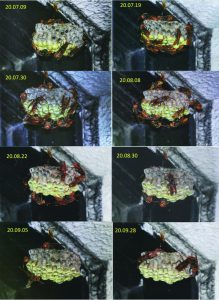Abstract / Introduction / Summary:

The paper wasp Polistes formosanus Sonan, 1927 is one of the least-studied polistine wasps in Japan for nesting habits and life cycle. A mature nest of this species was serially photographed from 9th July 2020 through 3rd April 2021 from the same direction. The number of wasps on the nest was between 7 and 13 until 22nd August and drastically decreased thereafter to 4 and finally 0 on 3rd April, 2021. A few wasps (probably new queens) remained on the nest until 1st April for overwintering. The number of cells seems to have already reached the maximum number by 9th July 2020 because no construction work was observed after that (but healthy larvae were seen). On 19th July most of larvae were found dead or dying, and no larvae were seen on 30th July. All the cocoons observed on 9th July disappeared (due to eclosion of adults) between 19th and 30th July, meaning that the production of adults ceased during this period. During late August the dispersal of new queens might have started. Males were observed from 30th July to 22nd August. The maximum number of adults present was estimated at less than 20 provided that 20–30% of the adults were on foraging or resting on the backside of the nest so that they were not photographed. The nest was collected on 27th September 2021 and measured for three dimensions, then it was dissected to count the number of meconia (fecal pellets) deposited at the bottom of cells for estimating the total number of adults produced in this nest. The nest measured roughly 5 cm x 5 cm in diameter, and 23–28 mm in depth. The number of cells was 95, of which 57 had cocoon remnant, the others having produced no adults. Out of the 57 cells, nine had two meconia, suggesting that these had each produced two adults. The total number of adults produced in this nest was estimated at around 65. Mud wall was seen near the cell opening in three cells that had produced paper wasp adults. Probably small solitary hunting wasps nested in vacant old cells after all paper wasp adults had disappeared. An araneid spider, possibly a prey of the solitary wasp, was found dried in one of such cells. This indicates that the abandoned nest of Polistes formosanus can be utilized by solitary wasps as nesting site.
